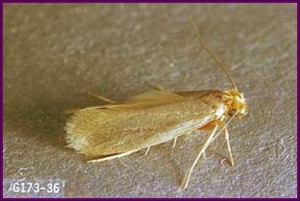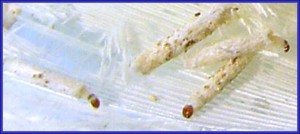
Clothes moths
Clothes moths (Tineola bisselliella & Tinea pellionella)
The webbing clothes moth, Tineola bisselliella, and the casemaking clothes moth, Tinea pellionella, are occasional fabric pests in Michigan. Clothes moths are weak flyers and are not attracted to lights. They tend to hide when disturbed, and for this reason, infestations of clothes moths are not usually noticed until damaged woolens, furs, or feathers are found. Close examination of the objects reveals the presence of silken webs that are spun by the larvae.
The webbing clothes moth is the most common fabric moth. Adults are only about 1/4 inch in length. They are golden colored with reddish golden hairs on top of the head. The moth has a wingspan of about 1/2 inch and the wings are fringed with a row of golden hairs. Because the moths are weak flyers and not attracted to lights, they are usually found very close to the infested items such as in dark areas of closets. Casemaking clothes moths are similar in size and appearance to webbing clothes moths. The wings of the casemaking clothes moth are more brownish than those of the webbing clothes moth and have faint dark-colored spots. Hairs on the head are lighter colored than those of the webbing clothes moth. Larvae of both species are nearly identical, except that larvae of the casemaking clothes moth always carry a silken case with them as they feed. They never leave this silken tube, but enlarge it as they grow. They feed from either end and retreat into it when disturbed. This case takes on the coloration of the fabric that larvae feed on.
Females of both species of clothes moth lay an average of 40 to 50 eggs over a period of 2 to 3 weeks and die once egg laying has been completed. Males outlive females and continue to mate during the remainder of their life. Eggs are attached to threads of fabric with an adhesive secretion; they hatch in 4 to 10 days during warm weather. Larvae molt from 5 to 45 times, depending on indoor temperatures and type of food available. The larval period lasts from 35 days to 2 1/2 years. Larvae are shiny white with a dark head capsule. They spin webbing as they feed and may partially enclose themselves in a webbing cover or feeding tube, depending on species. Excrement of the clothes moth may contain dyes from the cloth fibers being consumed and thus be the same color. When they are ready to pupate, larvae wander away from their food source to find crevices and other protected sites. In the case of the casemaking clothes moth, pupation takes place inside the case, usually on the fabric.
Pupation lasts from 8 to 10 days in summer, 3 to 4 weeks in winter. Heated buildings enable clothes moths to continue development during winter months. Generally developmental time for the clothes moth from egg to egg is between 4 to 6 months, and there are generally two generations a year.
The larva is the damaging stage of the clothes moth. Both species feed on wool clothing, carpets, rugs, upholstered furniture, furs, stored wool, animal bristles in brushes, wool felts in pianos, and fish meal in fish food. Synthetics or fabrics such as cotton are fed on if they are blended with wool. Larvae may use cotton fibers to make their pupal cases. Damage typically occurs in hidden or secluded locations such as under collars or cuffs of clothing, in crevices of upholstered furniture, and in areas of carpeting covered by furniture. Fabrics stained by foods, perspiration, or urine are more subject to damage.
Clothes moths can be controlled by a variety of methods, including periodic dry cleaning or laundering, proper storage, freezing, heating, or fumigating with dry ice, trapping, or using an insecticide. If humidity can be kept low inside buildings, this will create an environment that is not suitable for clothes moth development. Building construction that is free of many tiny cracks and crevices also contributes to fewer clothes moth problems. Good housekeeping practices are also important. Although most people can control clothes moth problems themselves, some infestations are best handled by a pest control operator who has the equipment, materials, and experience necessary to deal with a difficult control job.
Clothes moths may first become established on woolen garments or scraps stored for long periods. If such articles are to be saved, they should be stored properly, or periodically hung in the sun and brushed thoroughly, especially along seams and in folds and pockets. Brushing destroys eggs and exposes larvae. Larvae are strongly repelled by light, and will fall from clothing when they cannot find protection.
Dry cleaning or thoroughly laundering items in hot water (temperature above 120°F for 20 to 30 minutes) kills all stages of insects. This is the most common and effective method for controlling clothes moths in clothing, blankets, and other washable articles. (Because many woolen garments should not be washed in hot water, dry cleaning may be the only suitable cleaning option.) Keeping fabrics clean also has another advantage: insects are less likely to feed on clean fabrics than on heavily soiled ones.
Clothes moths often damage articles that are not stored properly. When storing susceptible items, be sure they are pest-free and clean. Place them in an airtight container; if the container is not airtight, layer paper every few inches in the container and place moth balls, flakes, or crystals on the paper. These materials contain naphthalene or paradichlorobenzene (PDB) and should not be placed in direct contact with plastic buttons, hangers, or garment bags or they may cause the plastic to soften and melt into the fabric. As these chemicals evaporate they produce vapors which, in sufficient concentration, will slowly kill insects. The vapors build up to the required concentration only in an airtight container–if not in an airtight container, the chemicals only weakly repel adults and the larvae already on clothes continue to feed.
If clothes moths are detected, articles that cannot be dry cleaned, laundered, heated to temperatures over 120°F, frozen, kept in cold storage, or fumigated with dry ice (see below) can be sprayed with an insecticide. Find a product that lists clothes moths on its label and follow the directions exactly. Insecticides for clothes moths usually contain pyrethrins or permethrin. Pyrethrin insecticides provide quick knockdown of clothes moths, and most can be sprayed directly on fabrics if needed (in situations where fabrics cannot be laundered or dry cleaned). Pyrethrin insecticides do not leave persistent toxic residues, which makes them more suitable for clothes moth control in many cases than products containing permethrin. Insecticides with residual control, such as those containing permethrin, are best used along baseboards, margins of carpets, in closets, and in storage areas. They also may be sprayed under furniture and other areas where moths occur.
Be sure to read and follow all instructions and safety precautions found on the label before using any pesticide.


Clothes moths (T. bisselliella ) Larvae



 Print
Print Email
Email




